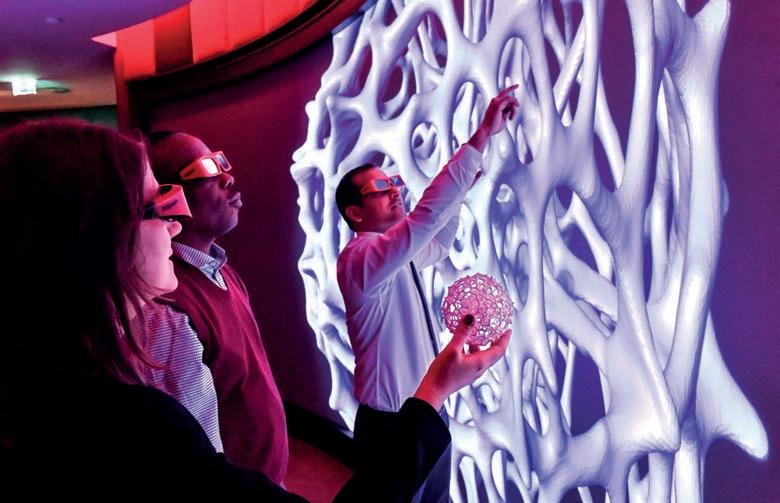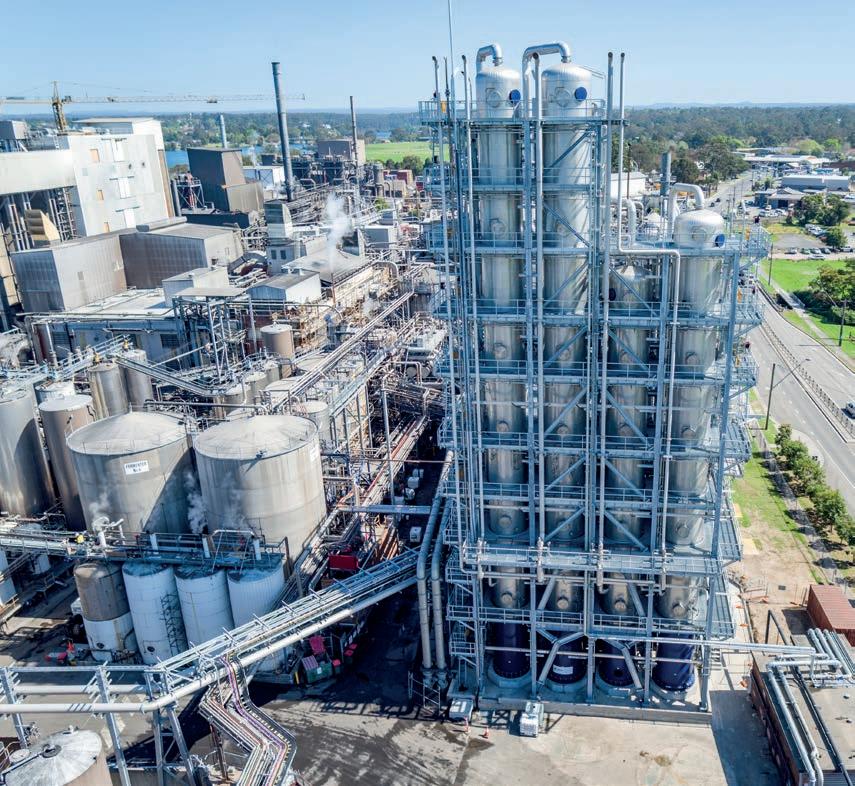
8 minute read
AI and the energy transition
Artificial intelligence is spurring innovation and optimisation throughout Shell’s upstream, midstream and downstream operations, writes Brian Davis.
Artificial intelligence (AI) is playing a significant role in the energy transition. As digitalisation facilitates development of new energy systems, AI is being deployed to optimise energy efficiency and decarbonisation across supply and value chains.
Advertisement
Sensor-based technology via the Internet of Things (IoT) generates vast data sets that can be processed in real-time on the cloud, using AI to observe, interrogate and analyse operational performance. Furthermore, augmented and virtual reality (VR) offers visualisation of these data sets to create digital twins of physical assets.
Shell has been aggregating processed data sets into cloud-based data stores for decades to optimise processes, while AI has gained momentum more recently.
There have been three milestones in terms of data processing in the energy sector, explains Dan Jeavons, General Manager for Data Science. ‘First, Shell led the industry in scenario planning from the 1970s, with detailed statistical analysis. 2013 was a turning point, when Shell introduced advanced predictive analytics – recognising the importance of embedding artificial intelligence, which could be deployed in the field to support business operations.’
In 2017, Shell announced an overall digital strategy, led by Shell’s executive committee, that resulted in the establishment of a Digital Centre of Excellence which included AI. ‘This marked a big difference in terms of handling the volume of data available and the ability to embed models in the software,’ Jeavons remarks.
So, what is AI and machine learning?
Jeavons suggests that, in the broadest sense, AI is the ability of the computer to simulate human cognitive functions and activity. The key technology in this respect, whether natural language processing, robotic process automation or drones, rely heavily on machine learning.
Other technologies are used in conjunction, like edge processing, IoT and advanced visualisation. AI is often a collection of different technologies, but machine learning is at the core.
AI in practice
The energy business is a very physical business, running plants, offshore platforms, pipelines or refineries, through to fuel retail service stations. ‘Everything carries elements of risk that are observed using traditional methods of computation and rely on observation by humans, which can be error-prone,’ says Jeavons. Indeed, inspection of a large facility from end-to-end can take years. Whereas AI can accelerate the process.
Jeavons does not claim that a machine can do it better than a human. But he notes that utilising a multitude of machines, drones and robots equipped with cameras provides far more pictures of an installation and basic filtering, ‘so the human inspector can focus on higher value add in terms of risk analysis’.
Shell has developed a machine vision system so drone photos can be passed through a neural network to detect anomalies, automatically flagging up areas of corrosion, using deep learning capability for further investigation by inspectors and reliability teams.
For this reason, Jeavons prefers to talk about ‘augmented intelligence’ rather than artificial intelligence. ‘People often think of AI as a replacement for human cognitive function, but I don’t see it that way. AI is very good at scaled-up, advanced data processing – applying human-like screening capabilities to narrow down the search space in support of human decision-making.’ Basically, he sees augmented intelligence supporting human intelligence to make better decisions.
For example, 3D seismic processing is critical for subsurface exploration and involves vast amounts of data. Machine learning is being used to ‘de-noise’ seismic data, using deep learning and feature recognition to speed up seismic processing by 25%.
Predictive maintenance
Over the last few years, Shell has been working with C3.AI to scale AI-based predictive maintenance solutions to reduce costs and improve the productivity, reliability and performance of assets. Shell is monitoring over 8,700 pieces of equipment using machine learning across upstream and downstream operations, as well as integrated gas assets.
In February 2021, Shell launched the Open AI Energy (OAI) initiative with C3.AI, Baker Hughes and Microsoft, creating an ‘open ecosystem’ of AI-based solutions for the energy and process industries, as interoperable solutions for monitoring, diagnostics, prescriptive actions and services.
The first set of OAI solutions are designed to improve reliability and performance of Shell’s energy assets and processes, using an AI-based extension of the Baker Hughes’ BHC3 Reliability application and Microsoft Azure for process and maintenance engineers. Shell is offering modules through the OAI of predictive maintenance for control valves, rotating equipment and subsea electrical submersible pumps. ‘As a founding member of the OAI, we are developing a curated ecosystem of integrated solutions, like an Apple app-store for the process industry,’ quips Jeavons.
Shell has been aggregating a vast data lake over recent years, which features about 1.9tn rows of curated time-series data, using machine learning models for asset performance optimisation. AI is also integrated with Shell’s remote operation centres, saving millions of dollars identifying issues with control valves and compressors.
‘We are using the data lake to identify failure conditions and optimise asset performance. Ensuring that operations are safe and searching for new set points in control systems, to balance sufficient volume with reduced CO2 emissions,’ says Jeavons.
Shell has been working with Nigeria LNG, using AI for 1–2% volume increase from their LNG trains and a net reduction of CO2 emissions, equivalent to taking 28,000 cars off the road. Shell is also deploying some of its data sets for corrosion prediction across global operations, using computational fluid dynamics and machine learning.
Midstream and downstream
In 2018, Shell Lubricants introduced Shell LubeChat, the first AI-powered chatbot tool for B2B (business-to-business) lubricants customers. The chatbot is an online robot designed to give users real-time access to product support, technical services and lubricants data in the US, UK, China, India and other markets. Since then, Shell has built a raft of customer lubricant analysis, leveraging a large data set integrated with IoT devices deployed directly with customers to give real-time predictions of lubricant performance, using a software product called Remote Sense.
In its retail business, the Shell Go+ rewards programme also has underlying AI capabilities, using the Offer Decision Engine which processes a massive number of customer transactions daily, with offers and recommendations, with their permission. The Shell Go+ service is now being rolled out globally and is currently live in six markets.
AI-based predictive maintenance is being utilised in refinery and petrochemical operations for plant optimisation and inspection. AI is also being used to design new chemical plants, for example, to determine how to electrify some of the units.
Dow, The Netherlands Organisation for Applied Scientific Research (TNO), the Institute for Sustainable Process Technology (ISPT) and Shell have teamed up to electrify ethylene crackers, which aim to replace fossil fuel combustion in steam crackers, as the energy grid increasingly becomes renewable-powered. Collaboration between these parties to design an e-cracker uses machine learning to accelerate research. If you can electrify one steam cracker, this would be the equivalent of removing 350,000 cars from the road.
‘We are committed to bringing multiple players together to move forward in the AI space, because no one company can solve the world’s AI problems,’ remarks Jeavons. Furthermore, speed is paramount. ‘The energy transition and digital transformation are forcing us to move more quickly. Alliances are critical to accelerating our progress and enabling AI deployment at scale.’
Digital twin development
Shell and Kongsberg Digital have joined forces to create the Nyhamna Dynamic Digital Twin, to optimise how Shell designs, constructs and operates its assets. The contextualised 2D and 3D-interface platform (like Google Earth) enables frontline operators, engineers, data scientists and remote vendors to use fully integrated data and work processes to drive efficiency, optimise production and reduce emissions.
Digital twins require three capabilities, explains Jeavons. ‘First, is having the data in an accessible, scaled-up environment. The foundational capability must be in place to provide curated, streamed data to other capabilities. Today, the digital twin is vital because it creates a 3D context for the asset which brings together project initiation documentation and work-order information around the site, with qualitative data – on volume, temperature, pressure etc – in an integrated platform.’
‘Shell is now rolling out the digital twin concept across upstream, downstream and integrated gas operations globally, as well as in the rapidly growing renewables business. In parallel, Shell is developing its AI capability around reliability, inspection and asset integrity, and optimisation. Thirdly, with Kongsberg and C3.AI, Shell is developing interoperable capability, so it can take the physical context of the asset as a baseline and feedback the results of machine learning into the digital twin.’

Digital twin maintenance planning at Nyhamna
Photo: Shell/Kongsberg Digital
Further initiatives
AI is also a key component in the development of new ambitious developments like Northern Lights in the Norwegian sector of the North Sea, where Shell is partnering with Equinor and Total to develop a new carbon capture, transport and storage (CCTS) supply chain. Development is underpinned by work with Microsoft creating an underlying digital platform. Similarly, AI is being used to strengthen the monitoring of carbon capture and storage (CCS) at the Quest operation in Edmonton, Alberta, Canada.
‘The overall delivery speed, design optimisation and cost profile of new projects is being facilitated using advanced computation and AI,’ says Jeavons.
AI is also being used by Green Lots, a US-based electric charging venture owned by Shell New Energies, to optimise charging profiles throughout the day when configuring banks of charging posts. ‘This is a good example of how to use AI in the mobility space to maximise use of renewables while minimising infrastructure expenses’, explains Jeavons. Shell aims to have a network of 500,000 electric chargers by 2025, one of the short-term targets of its Powering Progress strategy.
AI also played a role at a recent hackathon run by Microsoft, where the winning Shell data science team demonstrated the use of Tropomi satellite data to track methane concentrations. ‘This is a promising line of research,’ notes Jeavons.
Indeed, AI shows significant promise throughout the value chain.
Main photo: Engineers assessing rock properties such as porosity and permeability using AI and virtual reality. Source: Shell







